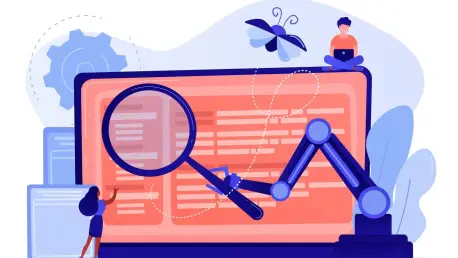In today’s fast-paced software development world, traditional quality assurance (QA) methods are increasingly deemed inefficient and labor-intensive. As companies press forward with digital transformation, they face an acute need to streamline testing processes without sacrificing accuracy or depth. Enter No-Code QA Automation, a burgeoning technology that promises to revolutionize how development teams achieve quality assurance by minimizing manual intervention. By providing a glimpse into this transformative domain, we aim to explore how no-code platforms like Treegress are reshaping the QA landscape.
Breaking Down No-Code QA Automation
No-Code QA Automation stands at the forefront of innovation, delivering a testing paradigm that simplifies quality assurance with reduced coding demands. This technology has emerged at a time when seamless integration and accessibility are key goals in tech ecosystems. By using intuitive interfaces, these platforms allow users—even those without technical expertise—to create and run tests effortlessly. Unlike traditional QA tools, which rely on scripted steps or complex configurations, no-code solutions offer a more democratized approach to testing activities.
At its core, No-Code QA Automation redefines the role of testers by granting them the tools to quickly build and modify test scenarios. The technology operates on pre-defined templates and automated test creation, enabling rapid adaptability to shifting software environments. This development empowers organizations to focus resources on strategic advancements rather than exhaustive manual testing routines, aligning with broader technological goals of efficiency and innovation.
Pioneering Features and Capabilities
User-Friendly Interfaces
One of the paramount elements of no-code platforms is their intuitive user interface, which significantly lowers the barrier to entry for users with varying skill levels. By providing drag-and-drop capabilities and visual workflows, these tools enhance accessibility and allow rapid test setup. Such features not only boost productivity but also foster collaboration across team members, enabling even non-technical stakeholders to participate in QA processes.
Automatic Test Generation
A standout feature of No-Code QA Automation is its ability to generate test cases automatically, a critical advancement in ensuring comprehensive application coverage. By analyzing application structures rather than their visible elements, platforms like Treegress offer a deep structural analysis of applications. This innovation supports the creation of intelligent test cases which adapt to functional roles within the software, enhancing test accuracy and relevance.
Adaptive Self-Healing
The introduction of self-healing capabilities marks a significant milestone, allowing test systems to auto-correct and adapt to changes in application elements. By identifying and addressing points of failure without human intervention, these capabilities ensure that tests remain valid and reliable over time, even as application interfaces evolve. This resilience is particularly valuable in agile development cycles where continuous integration and delivery necessitate frequent updates.
Recent Innovations and Developments
The last few years have witnessed significant progress in the realm of No-Code QA Automation, with advancements focusing on integration with existing development tools and improving the adaptability of test systems. Emerging trends indicate technology is becoming more embedded within broader DevOps practices, facilitating seamless transitions between development, testing, and deployment phases. Notably, startups like Treegress are gaining attention for their innovative use of intelligent agents, diverging from traditional pixel-based approaches.
In addition to process improvements, advancements in AI and machine learning have paved the way for more sophisticated test scenario generation and maintenance. The deployment of intelligent agents further enables action-based simulations, which enhance the quality and depth of automated testing processes.
Practical Applications in Diverse Sectors
No-Code QA Automation has found its niche across various industries, proving invaluable in sectors like e-commerce, finance, and healthcare, where rapid deployment and high-quality standards are paramount. In e-commerce, businesses leverage no-code tools to test myriad user scenarios, ensuring seamless user experiences without the delay of manual QA processes. Similarly, financial institutions deploy such platforms to test complex transactions swiftly and reliably, minimizing errors in online banking interfaces.
Additionally, unique use cases continue to emerge, demonstrating the adaptability of no-code solutions in unexpected fields. For example, media and entertainment companies utilize these tools for testing dynamic web applications, ensuring content delivery systems perform optimally across devices and user conditions.
Addressing Challenges and Limitations
Despite its promising benefits, No-Code QA Automation is not without hurdles. A primary challenge exists in tailoring the technology to significantly complex applications that involve overlapping functionalities and numerous dependencies. Moreover, questions around data privacy and security compliance demand ongoing innovation to satisfy regulatory standards.
Efforts to overcome these limitations involve constant refinement of testing algorithms and better integration with secure environments. Industry experts are closely monitoring advancements to ensure the technology remains robust and adaptable while remaining highly accessible to users.
The Future Trajectory
Looking ahead, No-Code QA Automation is poised for further expansion and refinement. Given the ongoing push for efficiency and cost-effectiveness in software development, no-code platforms are likely to integrate more advanced AI-driven insights and more adaptable ML models. This progression may pave the way for predictive testing, where systems preemptively assess potential points of failure based on historical data.
As the landscape evolves, the long-term implications of this technology hint at a future where automated QA systems function nearly autonomously, reducing the dependency on manual oversight and accelerating deployment timelines. In this envisioned future, platforms like Treegress could not only transform QA functions but redefine standards for software quality assurance across industries.
A Bird’s-Eye Perspective
Reflecting on the current state of No-Code QA Automation reveals a transformative phase that holds substantial promise for the future of software development. By addressing existing inefficiencies and elevating automated testing to new heights, this technology holds the potential to redefine how organizations approach quality assurance. The game-changing capabilities of platforms like Treegress indicate a decisive shift toward autonomous testing environments, setting the stage for sustained innovation within the industry. Recognizing these strides paints a picture of a rapidly evolving QA domain eager to tackle challenges and deliver unprecedented testing solutions.









